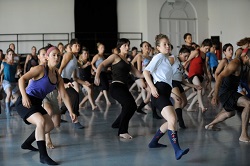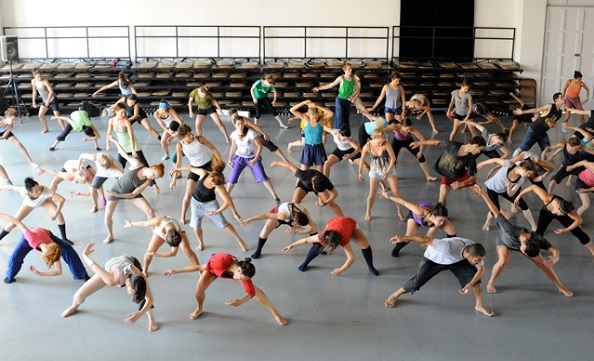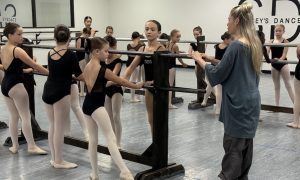By Kathleen Wessel.
My Road to Gaga
In 2005, I saw the Tel Aviv-based Batsheva Dance Company perform Mamootot at the Mark Morris Dance Center in Brooklyn, New York, and my world shifted. Never had I seen such raw physicality and wild choreographic choices, and never had I experienced such a visceral reaction to movement. When the performance was over, I was surprised to find myself sweating and exhausted, overwhelmed with the sense that I had just witnessed something entirely new.
Ever since, I have followed Batsheva Artistic Director Ohad Naharin’s work and his development of the movement language he calls “Gaga.” Though the infamous pop star still tops a Google search of the word, Naharin’s definition is gaining ground, and it is clear many American choreographers are paying attention. Gaga is not a technique, Naharin is quick to say; it is sensory-based, improvisational movement designed to unlock a wide range of physical possibilities.
Among dancers, I have heard Gaga dismissed as “nothing but a fad” and “just another improvisation class.” But if Gaga is simply improvisation, a form popularized in the 1970s, why all the hype? The short answer, for me, is Batsheva. The company takes Gaga every day, and, aside from the occasional ballet class, the only set choreography dancers learn is repertory. I have seen other companies (including Hubbard Street, Atlanta Ballet and the Alvin Ailey American Dance Theater) perform Naharin’s work, and there is no comparison. As Gaga-teacher Bosmat Nossan put it, we “behave, we don’t dance.” On stage, Batsheva dancers are humans with extraordinary power. They draw us in because we see ourselves in them, and we are astounded by the possibilities.
I wanted to see for myself if and how an improvisation-based class could create such a dancer. I wondered whether Naharin was just good at picking exceptional movers or if it really was Gaga that transformed them. Admittedly, I had my doubts. As a choreographer, teacher and professional dancer with extensive experience in improvisation, I didn’t need to be convinced of its importance. But I wondered if Gaga would offer a new perspective. I decided to find out.

The Gaga Intensive in Tel Aviv. Photo by Gadi Dagon
On Arrival
On the morning of registration at the Suzanne Dellal Center in Tel Aviv, Israel, I wondered if I had made a mistake. Here I was, a 32-year-old professional and professor of dance, jumping into a pool of bright-eyed, ready-to-please, 20-somethings. People were splayed out on the floor, flexible beyond belief, and dressed in cute, sloppy clothes that made them look “dancer chic” and only highlighted the dorkiness of my athletic wear. I felt like I was in high school all over again.
Then Ohad himself walked in, and I felt a little starstruck. Little did I know, the next two weeks would be fraught with mixed emotions like these – from crushing self-judgement to expansive revelations – and that my physical experience would mirror my shifting mental state. One day would bring glorious freedom from a nagging knee injury, the next debilitating soreness and fatigue. It didn’t take long to realize that, love it or not, Gaga gets under your skin.
Let Go
Over the course of the two weeks, these were the two words we heard most often. The concept usually applies to range of movement; “let go” in your lower back to find a deeper stretch, “let go” in your hip joint to lengthen your leg. But sometimes, it applies to more general tension that causes us to force movement, therefore making it look stiff and unnatural.
In one class, master teacher Yaniv Abraham had us practice “letting go” into jumps. This was extremely difficult as it seemed to conflict with obvious muscular mechanics. But after watching him effortlessly launch into the air and seem to float there without tension, I wanted to try. And I did feel a difference, if only slightly, in the ease of my jumps. Mostly, I liked this exercise because of the smiles around the room as we all hurled ourselves through space. It was as if everyone suddenly realized they could fly.
So what happened? Did Yaniv discover an antidote to gravity? My conclusion is that telling someone to “let go” taps into an emotional state more than a physical one. To “let go” can mean to quit harboring resentment or to stop holding on to unrequited love and move on. I remembered a class with Bosmat the week before where she admitted that some images from Gaga are more of a “state of mind” than an actual physical experience. Much of our physical pain, Ohad said later, is as much in our heads as it is in our bodies, and if – just for a second – we can let go of the tension and anxiety that binds us, we can experience the euphoria of free movement.
Through Thick and Thin
But sometimes theories didn’t match the practice. At the heart of Gaga is a belief in sensing movement rather than seeing and judging it; therefore mirrors are never allowed. That didn’t matter. I didn’t see my reflection, but I certainly judged myself, often thinking: Is this right? Am I feeling what I’m supposed to feel? My self-consciousness was echoed on the last day when a fellow participant told Ohad he sometimes felt “disappointed” in himself after class. To my surprise, Ohad admitted he knew the feeling well. Then he said, we should embrace it because “disappointment is connected to your ambition.” To judge ourselves is to acknowledge room for growth.
On some days, I had a thick skin against self-criticism and judgement; on others, I felt sensitive and susceptible to negative thoughts. Not by coincidence, we were often asked to make our movements “thick.” – “Put more flesh between your skin and your bones,” our teachers said, and instantly I felt a sense of invincibility and power. My movements became effortful and animalistic. In the next instant, we tried to embrace “sensitivity,” as if our once thick skin had turned paper-thin and now offered our bones scant protection from the elements. My tough exterior and penchant for fast, effortful movement made “thick” feel natural and “sensitive” or “delicate” feel foreign, as if I had stepped into another person’s skin. But then, that’s what I was here for: to surprise myself and find new ways of moving.
I’m Available
Admittedly, not every day brought such revelations. Some days, I found myself physically exhausted and tired of hearing the same words over and over again: float, let go, pull the bones, find sensitivity. They all started to blur together. And when we were asked to apply ideas from Gaga to the Batsheva repertory we learned each day, I often couldn’t do it. My mind was so full of information and directives, my body refused to respond, and all I was left with was frustration.
Ohad is big on layering ideas, and I think this is part of Batsheva’s secret recipe. The dancers are calm and animalistic at the same time. They move at lightning speeds with a sense of “plenty of time” – another commonly quoted directive. In one word, they are “available” to receive movement from any source or direction at any time. We were even given t-shirts that read “Available” on the front (imagine the confusion back home when I reveal my wedding ring). But isn’t this idea at the core of all good dance training and innovative choreography? Don’t judge, shed inhibitions and just move.
On the last day, Ohad told us he knows Gaga is not the only way to make a great dancer, a humble statement from a legendary choreographer. He’s right, but I’ll give credit to where credit is due. At its best, Gaga helps release physical (and often mental) limitations and offers a door to new experiences. And for that, I’m always available.
Photo (top): The Gaga Intensive in Tel Aviv. Photo by Gadi Dagon.













